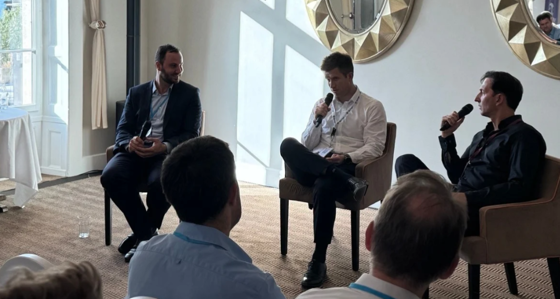
Redesigning trader incentives to secure better returns in volatile energy markets
10 October 2022
With capital being in unprecedented high utilisation, what are the smart ways to use available capital to get the best return in energy trading? One way is to rethink trader incentives and align them closely to your business strategy.
Energy trading is a capital-intense business activity. To succeed, not only do you need robust IT systems and a highly-skilled work force, but you also need a good amount of risk capital. With forward prices for power reaching an all-time high, the risk capital needed to enable trading becomes even more significant. While high volatility poses great trading opportunities for traders in the market, the implied risks are immense. The result is that trading opportunities are taken with care and outright exposures are strictly monitored. In this setting, it’s crucial to utilise the available risk capital in an economic way that aims for the best risk-return ratio in order to generate sustainable outcomes for your energy trading company as a whole. Incentivising the traders to take decisions accordingly becomes more important than ever.
So, how can we encourage traders to act economically when it comes to risk capital utilisation, whilst simultaneously taking good trading decisions in an erratic market? How do we ensure that a trader evaluates the associated market liquidity costs and the effects on a VaR-limit utilisation when taking a new position? How can we support traders in choosing between the option to trade via the exchange – possibly increasing liquidity needs for margin calls – versus via OTC – possibly using up the leftovers of credit limits?
Choosing the right KPIs to align capital-efficient trading decisions towards trader bonuses
The most effective way of aligning traders towards business objectives is the design of the bonus system. What does this look like in practice? To achieve better returns, the bonus system of energy trading companies needs to be enriched with KPIs that focus on the areas described below.
|
Bonus relevant PnL items |
Description |
Implications of increased Volatility to PnL items |
Implications of increased Volatility to Trader Behaviour |
|---|---|---|---|
|
YtD PnL |
YtD Realized + YtD Unrealized (MtM) |
Significant Daily PnL oscillations |
Traders seek to optimise risk/ return ratio |
|
(-) Transaction Costs
|
OTC trades: Broker fees and Collateral Costs |
Higher credit risk |
Traders have to optimize between OTC and Exchange
|
|
Exchange trades: Exchange fees and Interest Costs to meet margin requirements |
Higher liquidity risk |
||
|
(-) Liquid Market Risk Capital Charge |
The charge is levied against the risk capital that the company provided to each Business unit. The risk capital is a multiple of yearly average VaR. Charge covers the company’s return expectation over the risk capital |
Increased VaR due to volatility and disrupted correlations |
Possible position close-outs |
|
(-) Illiquid Market Risk Capital Charge |
Illiquid Risk Capital focus on risk for the position which cannot be closed out during the VaR framework (i.e 5/10days) |
Increased Illiquid Risk Capital |
Less tendency to trade in illiquid Markets due to more significant volatility |
|
(-) Working Capital Usage |
Commodities which the company trades considering Storage/Cargoes (especially Natural Gas, LNG and Oil) creates short term debts and long-term assets therefore impact on the company`s cash flow. |
Increased WC due to increased prices |
Less tendency to conclude high WC required deals |
|
(-) Bid/Offer Valuation |
Close-out cost of open position calculated based on the Bid/Offer spreads seen in the market. Depending on the company`s market access capacity, bid/offer spreads can be calculated as fixed or volumetric. |
Increased Bid/Offer spreads and valuations |
High tendency to conclude deals in most liquid markets |
Besides using the PnL to determine trader bonuses, we propose including transaction costs as well as a series of capital charges. KPIs, such as ROCE (Return on Capital Employed) or Cost of Closing, take into account the cost of capital and therefore support efficient capital usage.
Critical to success will be:
- providing transparency on these KPIs through reports therefore enabling traders to take these factors into consideration in their trading decision-making process
- reacting flexibly to market environment changes when it comes to capital allocation and the limit system to adjust accordingly
Having these KPIs in place (whether integrated in bonus system or simply informative in nature through reports) could play an important role in increasing traders’ awareness towards indirectly associated costs of trading and the cost of capital. Developing a well-integrated communication and monitoring process between the trading teams and risk function is an opportunity that cannot be missed. It is crucial for operating successfully in volatile markets.
In the face of extreme price volatility, business as usual is no longer sufficient. At Baringa, we are working with CROs of energy trading companies to help them respond to this unprecedented challenge by strengthening their risk frameworks, introducing models for capital charges and allocation of indirect cost to corresponding business units, and enhancing their risk monitoring and reporting systems. To discuss how we can support your business, contact Andrey Shutov.
This is the second part of a blog post series designed to help trading organisations understand and address the challenges presented by price volatility.
Related Insights

AI revolution in energy and commodity trading
On June 25th, Baringa, Salesforce, and Terranoha welcomed industry leaders from commodity trading, and technology in Geneva for an insightful conversation on how AI is transforming the trading world.
Read more
Preparing for the EU's regulation on deforestation-free products
Is your supply chains prepared for the incoming EU Deforestation Regulation? In this article we share what you need to know in preparation for the new regulation, and how Baringa can help you.
Read more
Commodities and energy trading video series
Join us as we delve into key areas that are shaping the trading industry
Read more
Digital transformation and decarbonisation in the energy sector
Energy leaders are using digital technologies and data to fast-track their journeys to decarbonisation.
Read moreIs digital and AI delivering what your business needs?
Digital and AI can solve your toughest challenges and elevate your business performance. But success isn’t always straightforward. Where can you unlock opportunity? And what does it take to set the foundation for lasting success?